AI tools like Grok and ChatGPT are changing how day traders approach cryptocurrency trading, detecting shifts in sentiment in real-time and turning them into structured trading plans.
Key points to remember
Grok detects bursts of sentiment volatility in real-time from X that often precede short-term price movements, but not all bursts are reliable.
ChatGPT turns those signals into trading plans, helping to establish entry parameters, exit points, and risk based on technical and fundamental context.
AI tools cannot replace judgment. You will learn how to add volume filters, check whale flows, and confirmation rules to avoid emotional or manipulated trades.
Logging trades with ChatGPT helps you improve your win rate, avoid repeating mistakes, and build a system based on reflection rather than just reaction.
Day trading rules are changing rapidly. What used to take hours to analyze can now be done in mere seconds, thanks to a new type of AI tool.
This article explains how traders are quietly using platforms like ChatGPT and Grok to gain an edge in the 24/7 cryptocurrency world, sometimes in ways you might not expect.
What is day trading cryptocurrency?
Day trading cryptocurrency means entering and exiting trades within the same day, sometimes in just a few minutes, to take advantage of small and rapid price fluctuations. This is a short-term investment strategy focused on momentum, volume, and speed, rather than long-term holding.
Here’s how it works:
Identifying trends: Traders work on 5-minute to 1-hour charts, monitoring breakout patterns. Indicators like RSI, MACD, or sudden volume spikes often confirm these moves.
Definition of trade
Entry point: Just above the breakout level or resistance level on the chart.
Stop-loss: Just below the support level or recent breakout.
Take profit: Based on resistance areas, Fibonacci targets, or fixed reward/risk ratios (e.g., 2:1 or 3:1).
Day traders aim to profit from short-term price fluctuations within the day, often opening and closing positions within a single trading day. This style heavily relies on technical analysis, discipline, and tight risk management.
Why day trading cryptocurrency is different
The cryptocurrency market is much more volatile and operates 24/7. The order book can be thin, and market sentiment on social media plays a significant role. That's when tools like Grok (for early sentiment alerts) and ChatGPT (for structuring setups) come into play; they help cut through the noise and make quicker decisions.
For instance, in early June 2025, Solana's DeFi activity surged, and its total value locked (TVL) surpassed $9 billion, a sign of real growth momentum. Traders might have used Grok to detect trend changes early and ChatGPT to help structure trade setups, including planning entry points, setting stop-loss orders, and profit targets.
How to identify trending cryptocurrency trading opportunities with Grok
Grok, accessible on X (x.com or the X app), grok.com, or the Grok app, helps traders detect cryptocurrency trends through real-time sentiment, market data, and news analysis.
Whether you're looking for breakthrough tokens, technical entries, or early scam alerts, Grok can help you spot opportunities quickly and accurately.
Here are three practical ways to use Grok in your day trading cryptocurrency strategy:
1. Monitor X sentiment regarding token hype
How it works: Grok scans X posts for spikes in mentions of tokens or shifts in sentiment, signaling potential price increases (e.g., a 7-fold increase in mentions of $WIF often predicts a price surge).
Access:
Free: 10 messages/2 hours, three analysis images/day. Suitable for one or two token checks daily; may miss rapidly spreading hype information.
Paid version: X Premium ($8/month, $84/year), Premium+ ($16/month, $168/year) or SuperGrok (pricing available at https://x.ai/grok) allows for frequent querying. Think Premium+ mode refines sentiment analysis.
Example prompt:
"What are X's thoughts on Pi Coin?"
Here are the results:
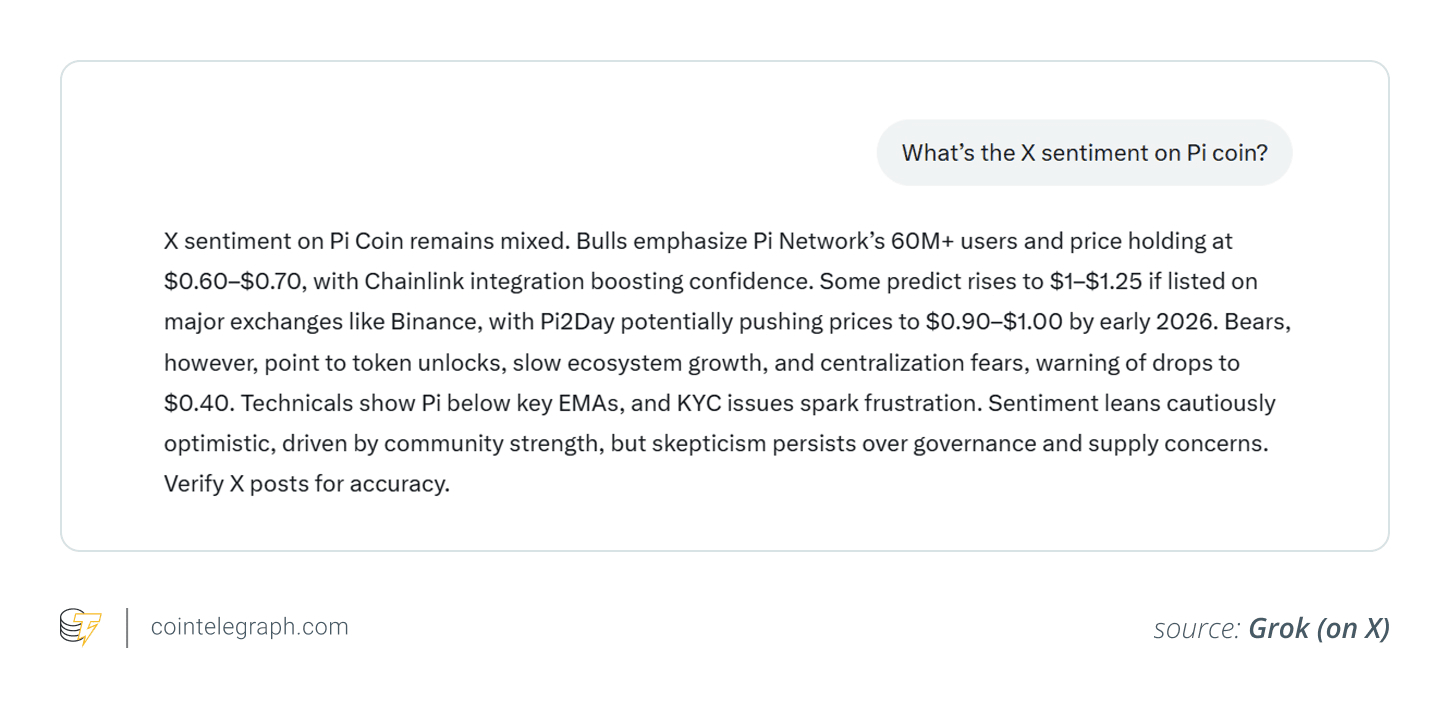
Grok reports mixed sentiment on Pi Coin: buyers see price potential from $1–$1.25 with a strong community and Chainlink backing, while sellers caution about a drop to $0.40 due to unlocking, centralization, and KYC issues.
2. Check technical indicators (via Grok.com)
How it works: Grok pulls real-time data (e.g., RSI) from sources like CoinMarketCap to determine when to trade (e.g., BTC's RSI at 62 signals bullish momentum).
Access:
Free: 10 messages/2 hours, limit of checking indicators 1–2 times per day; suitable for trend traders.
Paid: Higher quotas allow for multiple checks (e.g., hourly BTC, ETH). Premium+ DeepSearch enhances technical analysis (TA) support based on the web.
Example prompt:
"What is Bitcoin's RSI as of July 9, 2025? Please give me a concise answer with a valid reason."
According to Grok, Bitcoin's RSI was 54 on July 9, 2025, using a 14-day timeframe, indicating neutral momentum (see the image below).
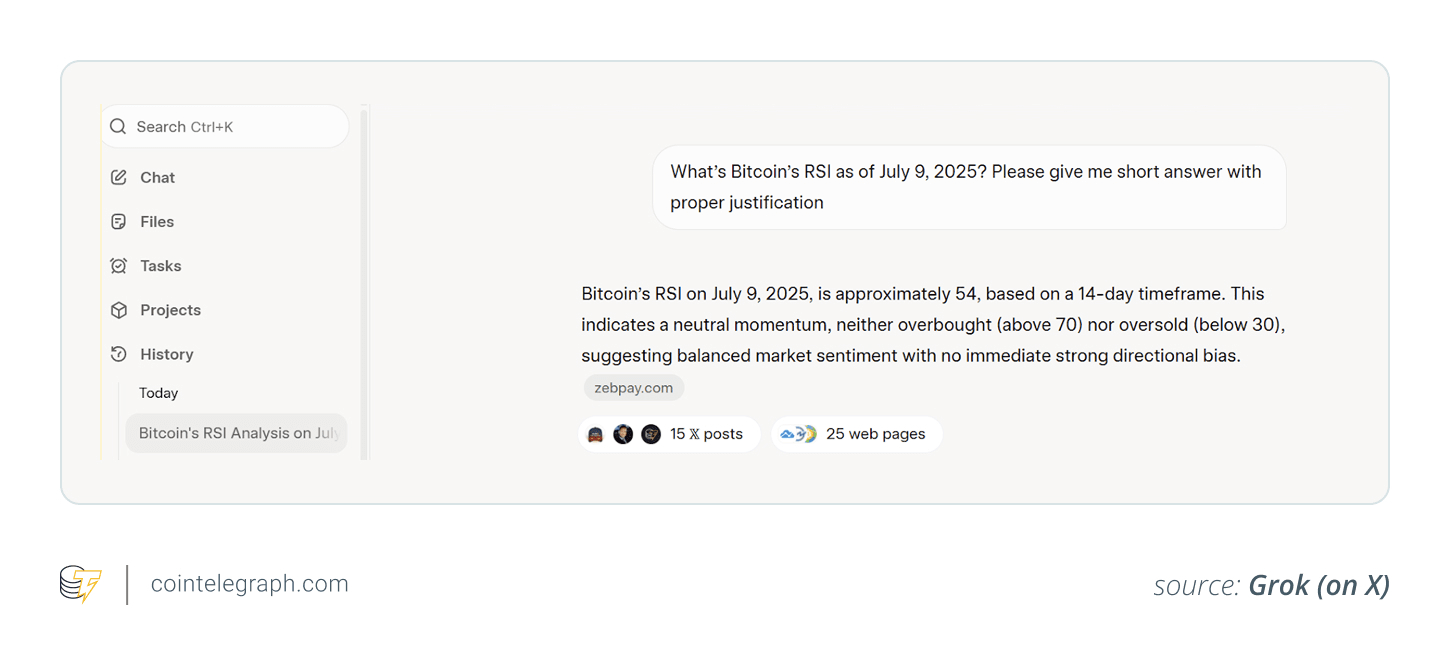
3. Verify the legitimacy of the token
How it works: Grok cross-references sentiment data and X web data (e.g., whitepapers, community feedback) to flag potential scams or assess fundamental factors. This is crucial for memecoins like $GROK, which are associated with scam concerns.
Access:
Free: Query limits may slow the verification process for multiple tokens.
Paid: Higher quotas allow for verification of more tokens or deeper analysis (e.g., "Check the contract of $GROK for red flags")
Example prompt:
"Is Bittensor (TAO) a scam token?"
Based on the above prompt, Grok reports mixed sentiment on Bittensor (TAO): optimists see potential price increases from $1,000 to $10,000 by 2030 for this company's AI market, while pessimists emphasize issues of centralization, internal token control, cyberattacks, and governance, advising caution.
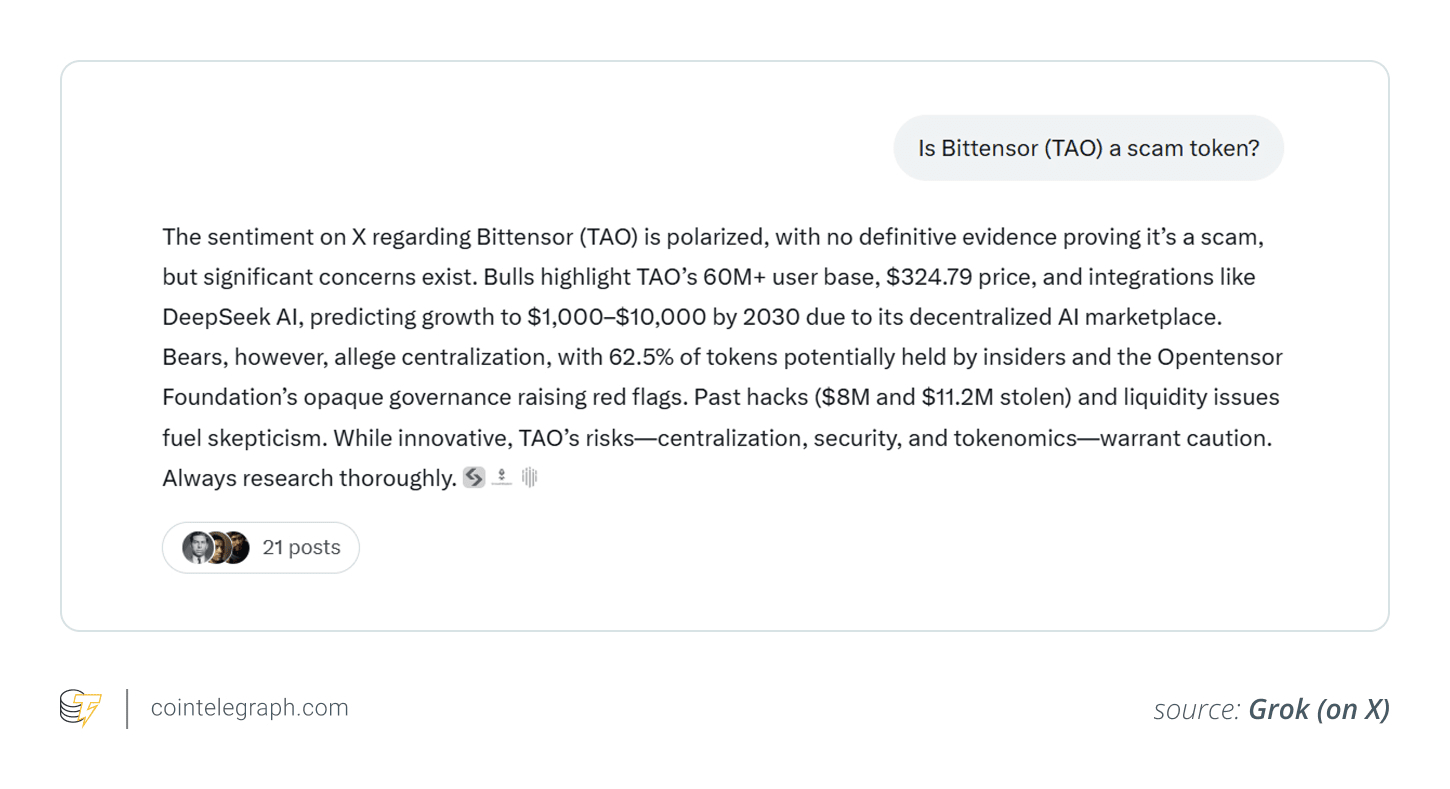
Insights on day trading from Grok use cases
A sudden spike in sentiment often occurs before price action; monitoring mentions on X can help identify a token's initial momentum.
Social media hype is a valid signal, especially in memecoin trading, but should be combined with other indicators.
RSI and other technical tools provide context, and combining sentiment with real-time indicators will improve timing and trade setups.
Grok can provide mixed insights, helping traders see both bullish potential and bearish risks (e.g., Pi Coin or TAO).
Fundamental checks are crucial; Grok's scam detection feature flags risks like centralization, unlocking, or governance issues.
Real-time data allows for quick decision-making, valuable in fast-moving day trading environments.
Structured prompts help refine trading plans; Grok can assist in building entry strategies, stop-loss orders, and exit points.
The limitations of Grok (and why they matter)
The free tier has strict limits on frequency and scope of queries.
Sentiment analysis may misinterpret tone or lack real-time reaction in highly volatile events.
No direct trading integration; this is an analysis tool, not a trading platform.
Quality quickly affects outcomes; vague or general prompts can lead to unhelpful results.
May not detect all suspicious signs, especially for new or less-known tokens with limited data.
Latency in refreshing data or updating indicators can impact trading timing in volatile markets.
How to use ChatGPT to structure cryptocurrency trades
After identifying a reliable signal with Grok, the next step is to turn it into a structured trade. That's when ChatGPT becomes a valuable assistant, helping you determine entry points, stop-loss levels, exit points, and even reviewing trades afterward.
Using the TAO example discussed above, here’s how ChatGPT can assist:
Example 1: Cautiously trading in an uptrend
Use case: Grok's output highlights the optimistic sentiment driven by user base, integration, and TAO's long-term growth potential.
How to trade (with ChatGPT):
Ask ChatGPT: "Based on the current bullish sentiment around TAO, what short-term price action would confirm momentum for day trading?"
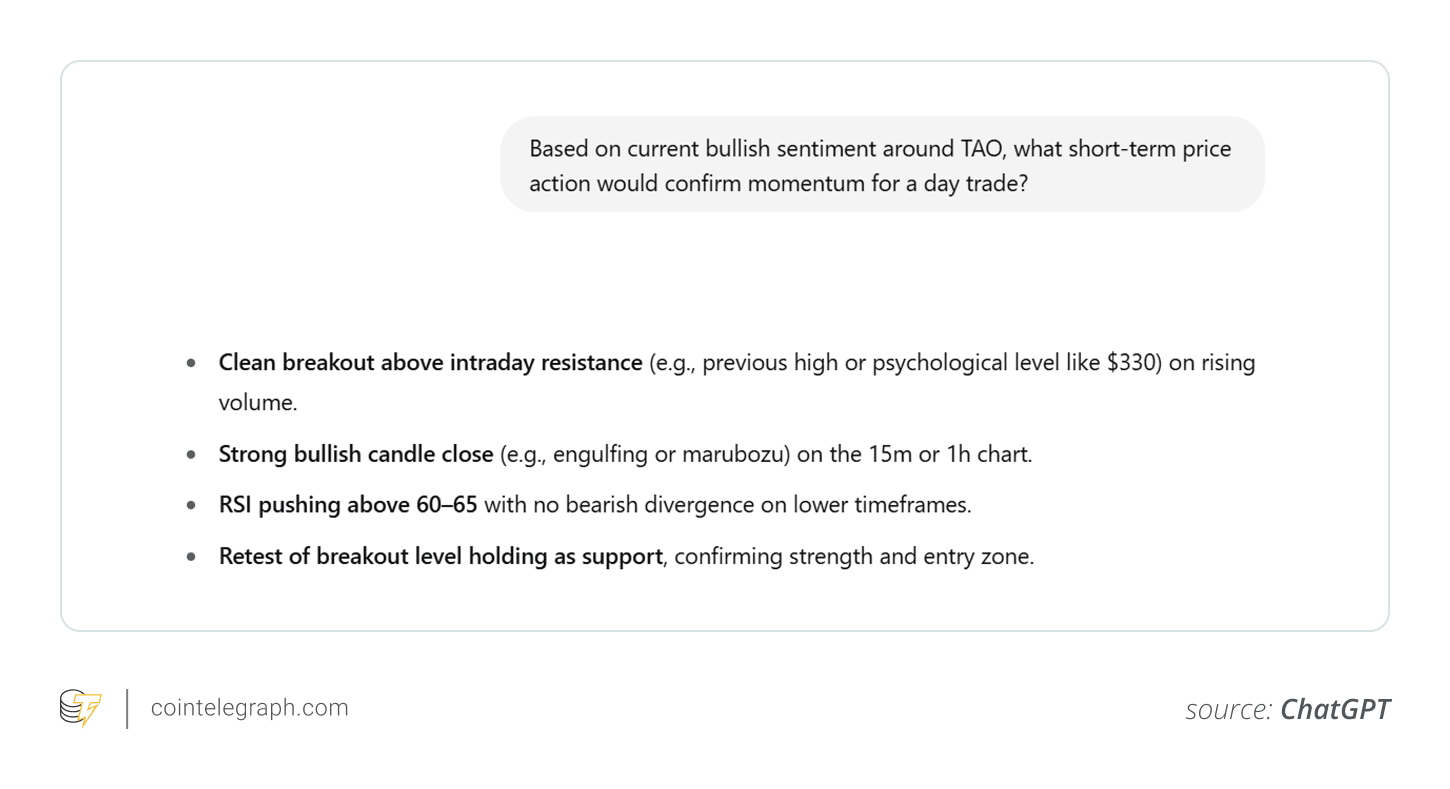
Example 2: Gradually reducing bullish momentum based on bearish risk factors
Use case: Grok highlights serious concerns such as token centralization, lack of transparency in governance, and past attacks.
How to trade (with ChatGPT):
Ask ChatGPT:
"With the bearish sentiment and risk factors for TAO, what are the safe conditions for short-selling right now?"
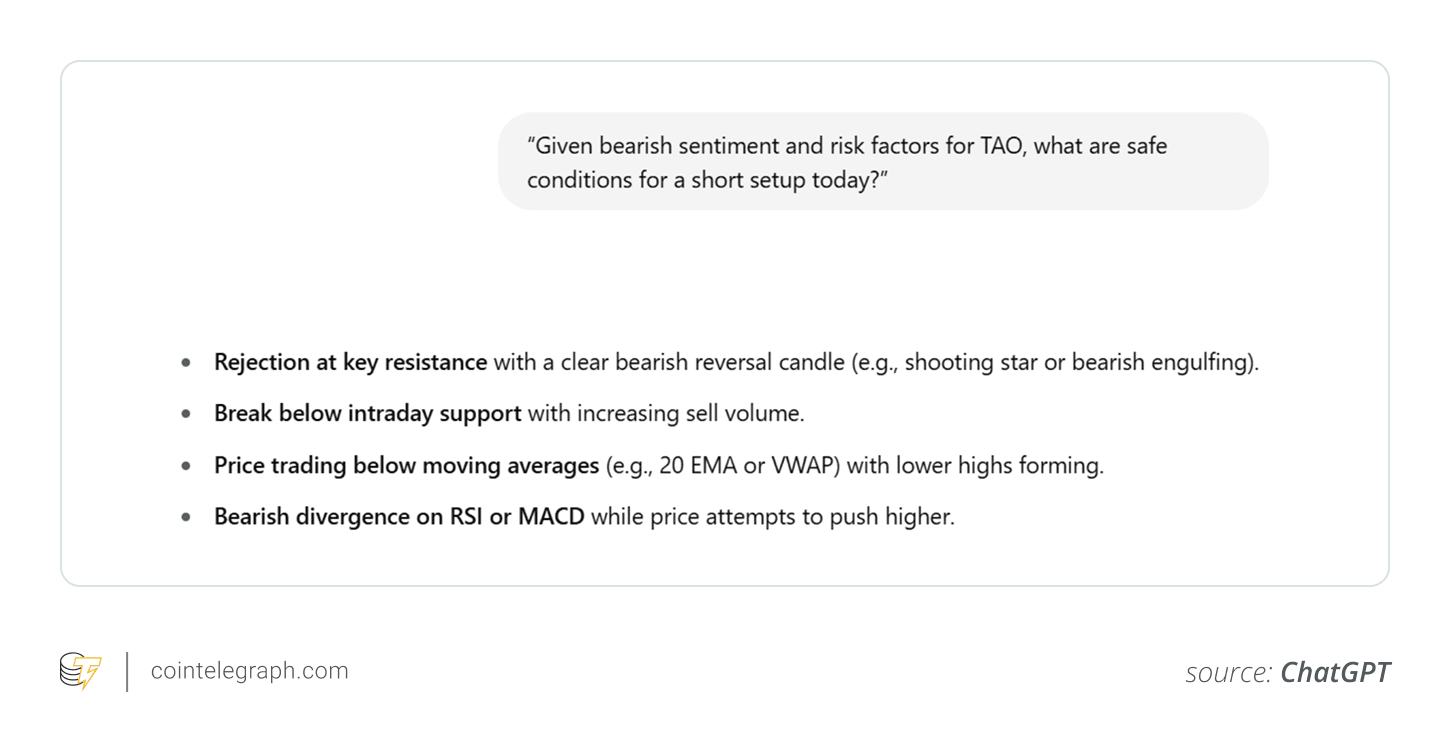
The Limits of AI in Trading: What It Still Can't Do
Artificial Intelligence (AI) is changing how traders operate, but it is not a crystal ball. Tools like Grok and ChatGPT can analyze sentiment, summarize market noise, and help build plans faster than humans. But speed doesn't equate to certainty, and automation cannot eliminate risk entirely.
The reality is: AI is only as good as its data and the user employing it.
Grok can detect shifts in sentiment, but it can't always determine if it's genuine motivation or coordinated hype. ChatGPT can help draft a perfect trading plan, but it cannot autonomously trigger, manage slippage, or sense real-time market changes.
AI has no role in the game.
It doesn't evoke feelings of FOMO, panic, or greed. That’s both a strength and a weakness. Without human judgment, AI tools can easily mislead as much as they can guide. Poor prompts, outdated data, or over-reliance on sentiment can turn a good idea into a bad trade. And while they may reflect past performance, they don't learn from experience like an experienced trader, unless you build that loop yourself.
So indeed, AI is very powerful. But it is not invincible.
And it certainly cannot replace strategy, discipline, or risk management.
Use it as an advantage, not a crutch.
Because ultimately, every trade depends on you.